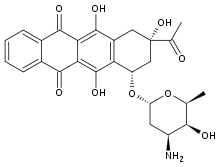All AbMole products are for research use only, cannot be used for human consumption.

Idarubicin prevents DNA from unwinding by interfering with the enzyme topoisomerase II. Idarubicin belongs to the family called antitumor antibiotics. Idarubicin inhibits the proliferation of NALM-6 cells with an IC50 of 12 nM. Idarubicin has significant cytotoxic activity against multicellular spheroids, comparable to the antiproliferative effects on monolayer cells. Idarubicin is currently combined with cytosine arabinoside as a first line treatment of acute myeloid leukemia. Idarubicin plus Decitabine and cytarabine has entered in a phase II clinical trial in the treatment of adult acute myeloid leukemia, and adult acute monoblastic leukemia, refractory anemia with excess blasts.

J Control Release. 2025 Feb 19;10:380:818-828.
Multidrug micelles and sonopermeation for chemotherapy co-delivery to brain tumors
Idarubicin purchased from AbMole

ACS Biomater Sci Eng. 2021 Dec 21.
Strategies to Maximize Anthracycline Drug Loading in Albumin Microbubbles
Idarubicin purchased from AbMole
| Cell Experiment | |
|---|---|
| Cell lines | K562S and K562R cells |
| Preparation method | MTT assay K562S and K562R cells were cultured in a 96-well plate (SPL) at a density of 1 × 104 cells in 100 μL of medium per well and treated with the indicated concentration of Imatinib or the AGM130 compound for 72 h. To measure the cell viability, the EZ-Cytox Cell Viability Assay kit was used. Ten microliters of MTT reagent was evenly treated in each well and incubated at 37 ◦C and 5% CO2 for 6 h. At the end of the incubation, the MTT factors of incubated cells in the plate were measured at the 450 nm wavelength using an ELISA detector. |
| Concentrations | 0~10 μM |
| Incubation time | 72 h |
| Animal Experiment | |
|---|---|
| Animal models | Imatinibresistant K562 cells xenograft model using BALB/c nude mice |
| Formulation | saline |
| Dosages | 15 mg/kg |
| Administration | i.p. |
| Molecular Weight | 497.49 |
| Formula | C26H27NO9 |
| CAS Number | 58957-92-9 |
| Solubility (25°C) | DMSO 50 mg/mL |
| Storage | 2-8°C, dry, protect from light, sealed |
| Related Topoisomerase Products |
|---|
| XR11576
XR11576 (MLN576) is an orally active inhibitor of topoisomerase I and II. |
| Silatecan
Silatecan (AR-67; DB 67) is a Camptothecin analogue with improved stability and lipophilicity. |
| 9-Hydroxyellipticine hydrochloride
9-Hydroxyellipticine hydrochloride is a inhibitor of Topo II and RyR. |
| Moxifloxacin-d4
Moxifloxacin-d4 |
| F14512
F14512 is a polyamine-containing inhibitor of DNA topoisomerase II with a broad spectrum of antitumor activities. |
All AbMole products are for research use only, cannot be used for human consumption or veterinary use. We do not provide products or services to individuals. Please comply with the intended use and do not use AbMole products for any other purpose.


Products are for research use only. Not for human use. We do not sell to patients.
© Copyright 2010-2024 AbMole BioScience. All Rights Reserved.
